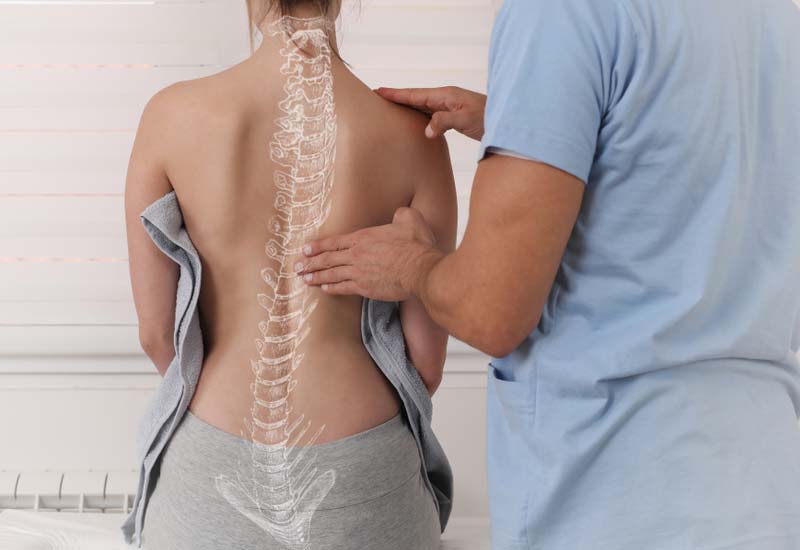Scoliosis and kyphosis are two common spinal conditions that can cause deformities and discomfort. In many cases, surgery becomes necessary to correct these conditions and improve the quality of life for patients. This comprehensive guide, written by Dr. Priyesh Dhoke, aims to explain scoliosis and kyphosis, their surgical treatment, and address common questions a layperson may have about these procedures.

What is Scoliosis?
- Understanding Scoliosis: Scoliosis is a medical condition characterized by an abnormal sideways curvature of the spine. Instead of being straight, the spine bends to the side, forming an “S” or “C” shape. This condition can affect people of all ages, but it often develops during adolescence.
- Causes of Scoliosis: The exact cause of most cases of scoliosis is unknown, but it can be linked to genetic factors or neuromuscular conditions like cerebral palsy. In some cases, scoliosis may develop without any identifiable cause, known as idiopathic scoliosis.
- Types of Scoliosis: There are different types of scoliosis, including:
- Idiopathic Scoliosis: The most common type with no known cause.
- Congenital Scoliosis: Present at birth due to abnormal spinal development.
- Neuromuscular Scoliosis: Caused by underlying conditions affecting the muscles or nerves.
- Degenerative Scoliosis: Occurs in older adults due to age-related wear and tear on the spine.
- Signs and Symptoms: Signs of scoliosis may include uneven shoulders, an asymmetrical waistline, or a tilted pelvis. In some cases, scoliosis can lead to back pain or difficulty in breathing.
What is Kyphosis?
- Understanding Kyphosis: Kyphosis is a condition where the spine curves forward, causing a hunched or rounded back appearance. It can occur at any age but is more common in older adults.
- Causes of Kyphosis: Kyphosis can be caused by various factors, such as:
- Poor posture
- Osteoporosis, which weakens the bones
- Congenital malformation of the spine
- Scheuermann’s disease, a growth disorder that affects the vertebrae
Types of Kyphosis: There are different types of kyphosis, including:
- Postural Kyphosis: Caused by poor posture and can be corrected with exercises.
- Scheuermann’s Kyphosis: A structural deformity affecting the vertebrae during growth.
- Congenital Kyphosis: Present at birth due to abnormal spine development.
- Age-related Kyphosis: Occurs in older adults due to weakened spinal bones.
- Signs and Symptoms: The main sign of kyphosis is a rounded upper back, often described as a “hunchback.” In severe cases, it can lead to back pain and difficulty breathing.
Scoliosis Surgery:
- When is Surgery Necessary? Surgery for scoliosis is considered when the curvature progresses significantly and poses a risk to the patient’s health or causes severe pain. The decision to undergo surgery is based on various factors, including the degree of curvature, age, and overall health.
- Preparing for Surgery: Before surgery, the patient undergoes a thorough evaluation, which may include imaging tests and medical history review. The surgeon will explain the procedure, potential risks, and expected outcomes to the patient and their family.
- Surgical Procedure: The most common surgical approach for scoliosis is spinal fusion. During this procedure, the surgeon straightens the curved spine and fuses the vertebrae together using special implants, such as rods and screws. This stabilizes the spine and prevents further curvature.
- Post-Operative Care and Recovery: Following surgery, patients will stay in the hospital for a few days. The recovery period varies from person to person but may take several weeks to months. Physical therapy and follow-up appointments are essential for proper healing and rehabilitation.
Kyphosis Surgery:
- When is Surgery Necessary? Surgery for kyphosis is typically recommended when the curvature is severe and non-surgical treatments have not been effective. The decision for surgery is based on the degree of curvature, age, and the patient’s symptoms.
- Preparing for Surgery: Before the surgery, the patient undergoes a comprehensive evaluation, including imaging tests and medical history assessment. The surgical team will discuss the procedure, potential risks, and expected outcomes with the patient and their family.
- Surgical Procedure: The most common surgical procedure for kyphosis is spinal fusion. In this procedure, the surgeon corrects the forward curvature and stabilizes the spine by fusing the affected vertebrae together using rods, screws, or other devices.
- Post-Operative Care and Recovery: After surgery, the patient will spend some time in the hospital for observation and recovery. The full recovery process may take several weeks to months, and physical therapy will be an integral part of rehabilitation.
Frequently Asked Questions (FAQ):
What are the non-surgical treatment options for scoliosis and kyphosis?
Non-surgical treatments may include observation, physical therapy, bracing, and pain management. However, if the condition worsens or causes significant discomfort, surgery may be considered.
How long does it take to recover from surgery?
Recovery time varies depending on the individual and the type of surgery. Generally, patients can expect several weeks to months of recovery, during which physical therapy plays a crucial role.
What are the potential risks and complications of scoliosis and kyphosis surgery?
Like any surgical procedure, scoliosis and kyphosis surgeries carry potential risks, such as infection, nerve damage, and hardware failure. However, these complications are relatively rare, and your surgeon will take necessary precautions to minimize them.
Can scoliosis or kyphosis recur after surgery?
Surgery aims to correct and stabilize the spine, reducing the risk of recurrence. However, regular follow-up and adherence to the doctor’s advice are essential for long-term success.
Will I be able to lead a normal life after the surgery?
Most patients can resume normal activities after recovery, but this may vary depending on the individual and the extent of the surgery. It is crucial to follow post-operative guidelines and engage in physical therapy to achieve the best results.
Can adults undergo scoliosis or kyphosis surgery?
Yes, adults with scoliosis or kyphosis may be considered for surgery if their condition is severe and causing significant discomfort or impairing their quality of life.
Conclusion:
Scoliosis and kyphosis surgeries are essential procedures for correcting spinal deformities and improving the well-being of patients. It is crucial to seek early diagnosis and appropriate medical advice to determine the most suitable treatment approach. While surgery is a significant step, it offers a chance to regain a better quality of life and enjoy daily activities without the limitations posed by these spinal conditions. Always consult with a qualified spine specialist like Dr. Priyesh Dhoke to make informed decisions about your health and treatment options.



















